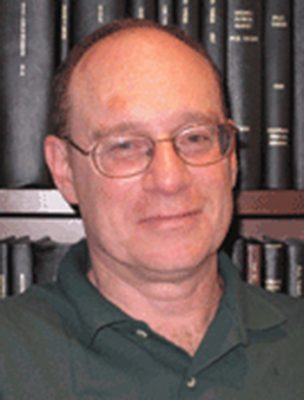Professor Emeritus of Chemical and Biomolecular Engineering, Richard Parnas, has been working on solutions to the oily waste we humans produce on a daily basis. He has been on a journey to convert that waste into usable energy. This quest has led to the patent of proprietary technology and the formation of REA Resources Recovery Services, a company he co-founded. Along with his partners in the company and in partnership with UConn, Dr. Parnas set about to convert FOG (Fat, Oil, Grease) into biodiesel for the benefit of municipalities in the state.
In 2019, REA contracted with the City of Danbury to build a FOG to biodiesel processing facility at the city’s wastewater treatment plant. That project has entered the construction phase and Parnas, REA, and UConn are now looking forward to the day the facility converts its first oily waste into usable biodiesel. IMS News reached out to Dr. Parnas about his research, the Danbury project, and the future of wastewater management.

You have been researching and developing methods to convert FOG (Fat, Oil, Grease) into biodiesel fuel since 2006. When did you first become interested in biofuels and what about biodiesel, in particular, led you down your current path?
I’ve been interested in biofuels, and green processing and green materials in general, for many years before coming to UConn. One of the important motivations for joining UConn was to participate in the development of the green economy. An undergraduate helped get me started working on biodiesel in the summer of 2007 by simply requesting my help to set up a biodiesel synthesis reaction in a fume hood.
When you became Director of the Biofuel Consortium here at UConn, you moved the bar from six gallons of biofuel produced over the course of a year to over 50 gallons continual production daily less than three years later. When did you realize the scale at which you might be able to convert FOG into biodiesel? What were the obstacles you faced and how were they overcome?
We used the yellow grease from UConn cafeterias to make biodiesel at that time, and the scale of operations was determined by the yellow grease production rate from the cafeterias. As a Chemical Engineer, my goal is always to maximize the use of available raw materials, and waste as small a fraction of that raw material as possible. Shortly after we started the Biofuel Consortium, we polled the various food service establishments at UConn to determine the yellow grease availability, and found it to be over 100 gallons per week. We then designed, built and installed a 50 gallon batch system, and produced 2 or 3 of the 50 gallon batches each week.
There were a number of obstacles. Production at that scale is not a typical academic activity so we faced skepticism from the facilities folks that ran the fuel depot for the buses. They asked if our fuel would be any good and how we would prove it to them, so we had to set up testing capability. Our testing was developed and run by Prof. James Stuart, an analytical chemist. Prof. Stuart and I received a grant of over $600,000 dollars to set up a biodiesel fuel quality testing facility in the Center for Environmental Science and Engineering (CESE) to test our biodiesel and the biodiesel produced by private companies. We also faced skepticism from the UConn administration since we were operating at a much larger scale than is typical. Safety concerns are important when conducting such operations with students who are just learning how to handle chemicals.
REA Resource Recovery Systems, a company which you co-founded and worked in collaboration with UConn to patent exclusive technology, has entered Phase 4 of its planned development of a 5000 square foot facility in Danbury that will turn FOG into biofuel. How important is wastewater management for municipalities and what will be the benefits for the City of Danbury once the facility is online.
planned development of a 5000 square foot facility in Danbury that will turn FOG into biofuel. How important is wastewater management for municipalities and what will be the benefits for the City of Danbury once the facility is online.
I joined my two partners, Al Barbarotta and Eric Metz, to found REA at the end of 2017. The UConn patents were already in place for a piece of core technology called a counterflow multi-phase reactor that plays a key role in both the chemical conversion and in the product purification. Prof. Nicholas Leadbeatter from Chemistry is a co-inventor with me on that reactor, along with two undergraduate students. Beginning in 2015, I started working with a very low grade feedstock called brown grease, which is much harder to process than the yellow grease we had been working with earlier. Every single wastewater treatment plant in the world has a brown grease management and disposal problem, and every municipality has a wastewater management problem. In much of the world, wastewater management is required by law and heavily regulated to ensure that effluent meets standards for discharge into rivers and oceans.
Here in CT, the brown grease problem was handled by DEEP many years ago by mandating that certain wastewater treatment plants in the state become FOG receiving stations. Brown grease is the component of FOG that causes all the problems. These FOG receiving stations were given a small set of choices as to how to dispose of the brown grease they received, such as by landfilling or incineration. All the choices cost money and vectored pollution into the air, the land, or the water.
Danbury was mandated to become a FOG receiving facility several years ago, and undertook a general plant upgrade project to build a FOG receiving facility and then dispose of the FOG using biodigesters. When that disposal pathway became too difficult due to high cost they sought alternatives. REA was ready at that time to provide the alternative of converting the brown grease into a salable product, biodiesel. This solution provides two benefits to Danbury, an environmentally excellent disposal method and a source of revenue. REA estimates that the revenue will offset the cost of the project in Danbury in about 7 years, and that the payback period will be significantly shorter in larger facilities.
It has been 15 years since you undertook this journey of making biodiesel a viable alternative energy source. How does it feel to see your years of work coming to fruition with the Danbury project?
It feels terrifying because we have not yet started up the Danbury plant. When we successfully start Danbury, the relief and satisfaction will be enormous. Until then, for the next few months, everyone associated with the project is working very hard to finish the installation.
Since retiring in 2020, you appear to be just as active in your pursuit of science. What continues to drive you and is there anything you miss now that you have retired?
I am driven by the desire to see this biodiesel project through to completion and by the desire to play some small role in mitigating the unfolding climate catastrophe. When I started at UConn I was surprised that the academic definition of project completion is a final report. As an engineer, that did not seem to be enough because most reports are ignored and forgotten. Sometimes I miss the teaching aspect of working at UConn, but I think I most miss the camaraderie of my colleagues, with whom I have much less time now than I used to.